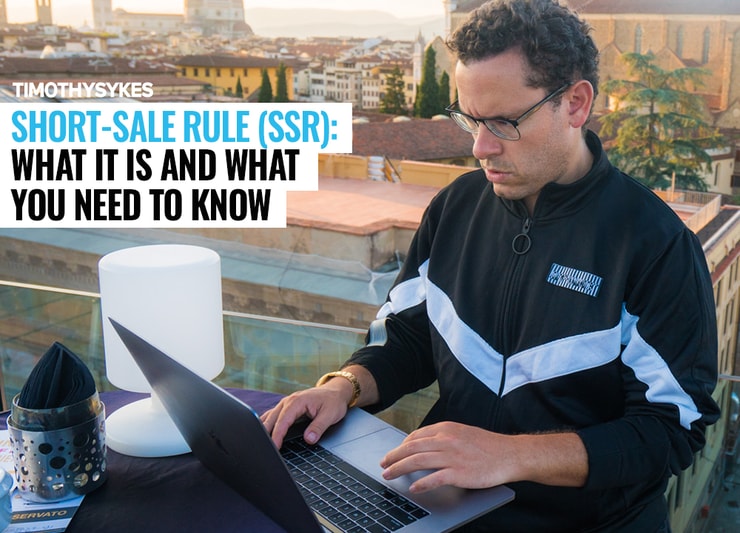The short-sale rule or SSR, is also known as the alternative uptick rule or SEC rule 201.
The SSR restricts short-sales on a stock that has declined in price by 10 percent or more from the previous day’s close.
Once triggered, the SSR remains in effect until the end of the following trading day. The rule applies to all equity securities whether traded on an exchange or over the counter.
The short-sale rule restricts short-sales on a stock that has declined in price by 10 percent or more from the previous day’s close.
While it might not sound too exciting, this kind of information is important to you as a trader.
If you want to learn how to short properly, apply for the Trading Challenge today. It’s one of many strategies I teach.
I don’t suggest short-selling as a strategy for newbies and those with small accounts. But I do recommend you learn everything you can about short-selling. Make it part of your education while you build your knowledge and trading accounts.
If you have no idea what short selling is then please read this to understand how short selling works. And this post for 10 things you should know about short selling. Those two posts give you a good overview. As an aspiring trader, you need to understand short-selling.
Table of Contents
Brief History of the Short-Sale Rule
What we call the SSR today is different from the original version in effect from 1938 to 2007. It’s good to understand why it started, why it was abandoned, and why a new version was established.
The Original Short-Sale Rule
Back in 1938, there was greater opportunity for stock price manipulation. Traders used brokers working the floor of the exchange. Computerized trading was still decades away.
It’s believed that groups of speculators were pooling resources and short-selling stocks to drive down prices. The downward pressure caused panics which allowed the speculators to profit.
The Securities and Exchange Commission (SEC) established the uptick rule to protect investors. It required every short-sale position to be entered at a higher price than the previous traded price. In other words, you could only short on the uptick.
That version of the rule was in place for nearly 70 years. It was finally repealed in 2007. At that time, the shift to decimal-based and electronic trading made the rule obsolete. Or so they thought…
The Financial Crisis and Re-examining the SSR
The wild market volatility and bear market of 2008 caused the SEC to re-think the short-sale rule. Some market experts believe the repeal of the original SSR helped create the market crash. The original short-sale rule came fast on the heels of the Great Depression. Likewise, the new SSR rule 201 followed the Great Recession.
Alternative Uptick Rule of 2010
The present-day version of the short-sale rule was announced on February 24, 2010, and implemented in May of that year.
According to the SEC press release, “the rule is designed to preserve investor confidence and promote market efficiency, recognizing short selling can potentially have both a beneficial and a harmful impact on the market.”
It differs from the 1938 rule in that there is a ‘circuit-breaker’ that triggers the rule and there’s a time limit. Check it out:
- SEC short-sale rule 201 is triggered when a security’s price declines by 10 percent or more from the previous trading session closing price. For example, if a stock closes at $1.00 on Monday and then drops by 10% to $.90 on Tuesday, the circuit breaker is triggered and Rule 201 comes into effect.
- Using the above example, the SSR remains in effect for the rest of the session on Tuesday and the entire day Wednesday.
How Does the Short-Sale Rule Work?

2025 Millionaire Media, LLCOnce the circuit breaker is tripped, short-sale orders can only be executed at a price higher than the current best bid. You can’t ‘hit the bid’ on a short-sale order with a stock under SSR. Which means you have to wait for the price to go up to your ask price for the order to execute.
Following on with the example…
The hypothetical stock drops all the way to 85 cents a share from the previous day’s close at $1.00. You’ve been waiting for a big crack to happen right around 85 cents. You’ve studied my ShortStocking DVD over and over. You’re sure when it breaks through 85 cents it’s bye-bye time for this stock. You’ve created a trading plan.
Under the short-sale rule, if the best bid is 85 cents you can’t short at 85 cents. You have to put in your short-sale order at a price higher than the bid. A bid for your (higher) ask price has to come through for the order to get executed. So it’s still an uptick rule. In that respect, it’s similar to the original SSR.
(I want to be clear — the above is an example to help make the SSR easy to understand. I don’t like to short stocks priced under a dollar. If you want to know the reason, join the Trading Challenge or at least watch my ShortStocking DVD. What you need to know about shorting is on the DVD, including more about the SSR.)
Is the Short-Sale Restriction Effective?
Sometimes the SSR is referred to as the short-sale restriction. It’s the same thing.
Is it effective? Does it do what it’s supposed to do?
That’s open for debate. There are studies which describe conflicting levels of efficacy of the SSR. Particularly for stocks at different price and trading volume levels. Whether it does what the SEC intended, the SSR is something you have to deal with as a trader.
Here’s my thought about it: it’s a rule you have no control over. What you can control is your education and your knowledge. You can gain the experience necessary to know the top time to short. And you can learn to navigate the alternative uptick rule should it be in effect on a stock you want to trade.
But you can’t cheat the effort required to gain the knowledge. There’s no ‘hack’ to get this. You have to put in the effort.
Short-Selling: A Cautionary Tale
Fair warning…
Short selling is not for newbies. If it seems I’m repeating myself, it’s on purpose. When you’re part of the Trading Challenge you’ll start to understand why.
Know this: if you short without proper knowledge and experience, you could lose a lot more than your investment in a DVD. In one trade. It might be the single best way to blow up a newbie account.
Why do I warn against short-selling for newbies? Think of it this way: When you trade long, the most you can lose is the amount you put into the trade. But if you’re shorting, the potential for loss is infinite.
For example, say you buy 100 shares of Company X for $1 each. The company goes bankrupt the next day and share value falls to zero. As unlikely as this is, your loss would still only be $100.
But what happens if things go wrong when you short?
Let’s look at a hypothetical short-sale: Say you short 100 shares of Company X at $1 each. The company announces positive earnings. They unveil a new product that revolutionizes the computer industry. They’re poised to become the next Microsoft overnight.
Say the stock spikes up to $11 in a matter of minutes when trading opens the next day. Now your loss is $1,000 — 10 times your initial investment. Ouch.
If you’re interested in short selling, then I hope, for your sake, you do one of two things right now. Either apply for the Trading Challenge or buy the DVD mentioned above. I’m trying to protect you.
More Breaking News
- SoFi Expands Financial Horizons with New Services
- Will Tesla Stock Bounce Back After Recent Woes?
- BitMine Stocks: Unprecedented Surge Explained
Trading Challenge
The Trading Challenge is one of the most comprehensive penny stock courses found anywhere. (In my opinion.) ShortStocking is only a small part of the vast library of trading knowledge available to Trading Challenge students.
Whether you’re brand new or you’ve been trading for a while — the Trading Challenge is ideal for you if…
- You’re ready to study and work hard. Harder than you’ve ever worked before.
- You’re teachable. And willing to pay attention and follow directions.
- You understand successful trading comes after a process of learning, testing, and tweaking. No get rich quick losers allowed.
- You have a burning desire to gain the skills necessary for potential success.
If you fit those criteria, apply today and be ready to tell my team why you should get accepted. It’s not for everyone.
Are you a trader? How has the short-sale rule affected your trading? New to trading? What are you doing today to prepare yourself as a trader? Comment below. I love to hear from all my readers!










Leave a reply